In Canadian Perspectives: Negotiating Borders
In celebration of the closing of the <Negotiating Borders> exhibition in Ottawa on January 27, the Korean Cultural Centre shares three reviews and responses to the exhibition written by three Canadian writers.
1. Negotiating Borders (after Crash Landing on You), Paola Poletto (December, 2023)
2. DMZ, Paul Hong (December 2023),
3. Negotiating Borders: Korean Art, Maureen Korp (The OSCAR, December 2023)
-----
1.
Negotiating Borders (after Crash Landing on You)
Paola Poletto (December, 2023)
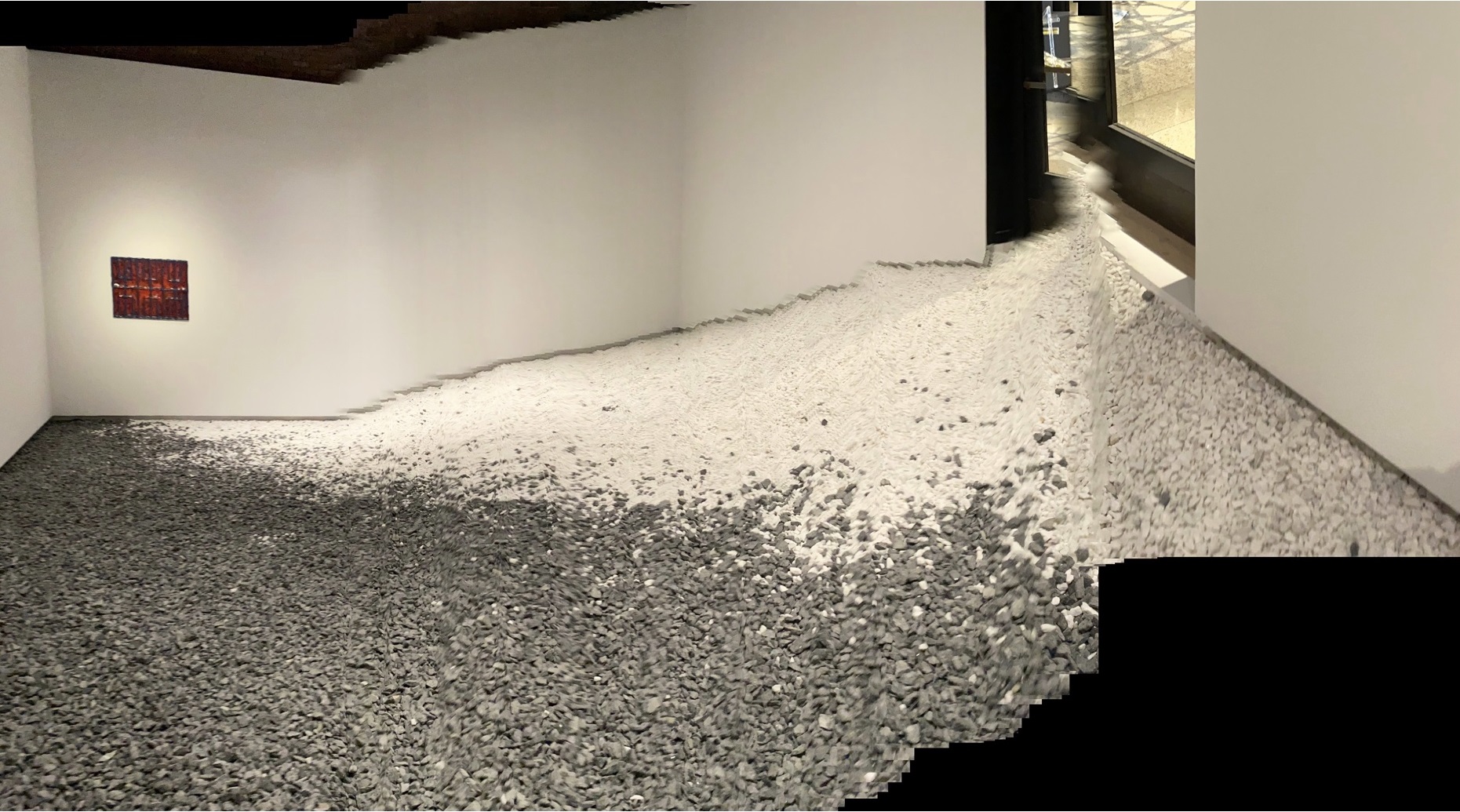
This photograph conveys my feeling of being in FRAKTUR (Fracture) (2018) by Jeewi Lee, situated in a cubed room divided diagonally on the ground by white rocks and dark grey ones. To enter the room, located at the far end of SAW Gallery in Ottawa, one had to step onto the grey rocks first, roughly from the view you are looking into now. The crunchy - crunch beneath my feet echoed upward and beyond the room, amplifying my every move. It was as if I was under audio surveillance in an otherwise quiet gallery setting. In writing this to you now, I have the privilege of having left the room. I have re-compartmentalized the experience as a white cube thrice removed by space-time, of being hemispheres away from a politically divided country, and interpreting trauma through aestheticisms.
On the north side of the room, top right of picture, there is a black-framed door, locked shut with a numbered lock pad: the glassed door looks into a hallway and across into the gallery’s administrative offices. In this photograph, the black-framed door is, metaphorically speaking, wonderfully ajar. It has made this photo response possible. I turn right to look at two framed takbon rubbings of trees in the DMZ, titled INZISION (Incision) (2018) not captured in this photo. They complement the floor work FRAKTUR (Fracture), both made by Lee. Their pairings echo what I experienced at the 2023 Gwangju Biennale, where multiple artworks made by the same artist show how their ideas germinate, carry and expand over time. Similarly, here, installations have grown tentacular arms with drawings and films meant to hug you and me, here, continents away from North and South Korea, with perhaps an offer to greater understanding of their political complexity. Lee’s individual art practice permeates. It renews with each new context and each new dialogue with an adjacent artwork, and another viewer.
I look left to the blood red wall work by the Nova Scotia-based HaeAhn Paul Kwon Kajander, a stylistic cast impression of residential burglar bars that were salvaged from the window of a demolished post-war home in Seoul. The deep blue and red colour of this work overlords the room like a monster. Indeed, I feel trapped in this room. I move my cameraphone to panoramic setting and begin to move through the space to take my photo. Each time I try to make my panorama, I get pulled in to the centre of the room, sucked down into the rocks. My movements hasten. We are at 38 degree angles, body and machine, a simulation of the DMZ’s 38th parallel north: the photographs stop, start, stop, start; I stop, start, stop, start, together, frustratingly out of synch. I have chosen this photo here as the most representative photo of being complicit in the collective desire to negotiate borders, to moon walk from ground with white rocks on north side to ground with grey rocks.
Into the other gallery, Ottawa-based Adrian Gollner offers an alternate mapping of the DMZ from Incheon to Cheorwon County with Trace (2023). A birdwatcher, he drew birds spotted on his journey walking publicly accessible parts of the DMZ. The drawings are pinned on the wall away from his blue vinyl line representing the GPS mapping of the zones he walked. The birds here, on this wall, most feet firmly planted, surround the no fly zone: they are, though, freely flying the DMZ.
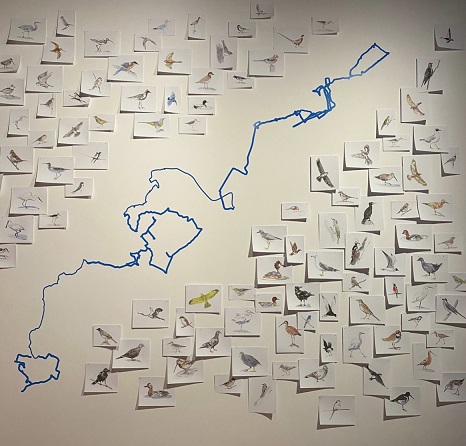
Across from this scene where every bird is named, is an encased child’s rubber boot, with drippings of paraffin wax over a blue sponge. Minouk Lim’s Farewell (2011) resonates across continents with sadness for every child lost to genocide. The sponge, sprawled out from the boot like wings, wishes it into flight like s spirited bird. The boot accompanies a video work also by Lim called It’s a Name I Gave Myself (2018) that culls footage from a 138 day-long news broadcast made in 1983 that attempted to reunite lost family members scattered and fractured by the Korean War. Lim brings into view the horrifying footage of children separated from their family 30 years prior. As adults they don’t know their own birth names and some use memories of childhood scars and other physical attributes to reunite with family. I stand by the boot and look back toward this picture now. It is a reminder that my cameraphone and these words are also transmission.
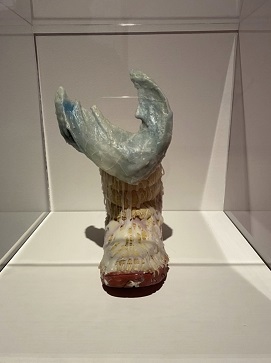
Artificial Sun (2017) a single-channel video installation by Chan Sook Choi projects an image of a common heater lamp, rotating left to right to left, found throughout the homes of elderly women living in the Civilian Control Zone of the DMZ. Positioned up high on the wall, the projection could also be a cartoon retro space blaster, echoing the NOWness of the “rising tensions after launch of spy satellite in defiance of UN sanctions” (McCurry, 2023).
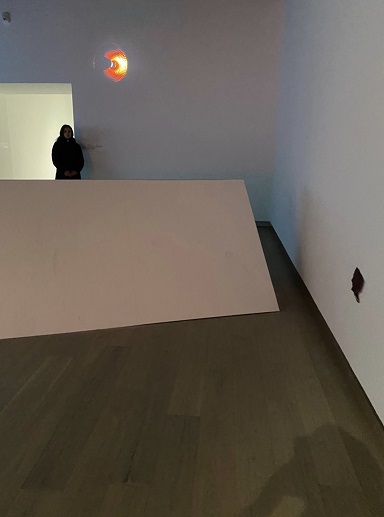
Opposite this radiating sun are two seaweed coloured lacquered flecks of fragmented South Korean newspapers pinned to the wall as part of HaeAhn Paul Kwon Kajander’s sprawled site-responsive installation, Leave Without Absence (2023). These and other material are scattered by the artists throughout gallery spaces as various debris and imprints, such as the one I describe in the picture above in the room with FRAKTUR (Fracture). As “ideological scabs” (Kajander, 2023) which the artists describe as part of a larger project that “explores the associative implications of thresholds that attempt to keep things separate, limit passage, but may also catalyze transformation or act as points of departure,” these two flecks, for me, are two urgent things: the mapping of Palestine and Israel and other brutal active wars that are entangling the way I see this exhibition; and… they are also the left over flakes of gim on our plates after our family finishes off all the gimbap halmoni has dropped off for dinner.
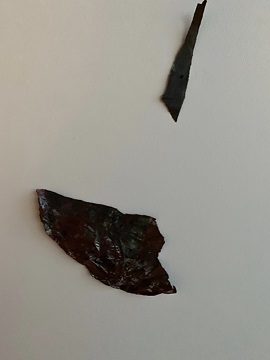
Notes:
Justin McCurry, “North Korea moves heavy weapons to border with South,” November 27, 2023, The Guardian, https://www.theguardian.com/world/2023/nov/27/north-korea-moves-heavy-weapons-to-border-with-south
Kajander, Paul & HaeAnn Kwon, e-mail correspondence with author, December 18, 2023
About:
I’ve travelled to South Korea 3 times, most recently to Suwon/Seoul, took a Train to Busan, and bus to Gwangju (2023). Travelling to and within this triangulation of places broadened my outsider understanding of regional cultural differences, politics and aesthetics beyond those I have gleaned from my partner Paul over 30 years, and more recently from popular Korean drama such as Crash Landing on You (2019/20), and comedic segments of Conan O’Brien and Steven Yeun travelling to the DMZ in 2016. The first time I travelled to Korea, Paul and I were recently married. He accompanied me first for work to Nagoya, Japan at the 2005 World Expo before staying with my in-laws in Suwon. The second time, my brother-in-law was married in a traditional Korean ceremony in the foothills of Seoul. Our daughters were lantern girls for Auntie Su and samcheon. My current practice-research works through the glitch panorama as a mapping site for embodied, multi-voiced experience. This is a methodology from which I can combine photography and words toward photopoetic response.
----------------------------------------------------------------------------------
DMZ
The plan is straightforward and contingent on building a time machine. Then, we go back in time to 1983 to KBS headquarters in Seoul.
KBS headquarters has 453 hours of tape from their original broadcast. They essentially did the initial audition process. It's a rice cooker rocking and bubbling with pent up unreleased emotions.
On tape number 112, you'll find the story of a man, a minam, named Kangjeon Kwang- Mo. He was 36 years old in 1983. When he was four, his mother left him with his neighbour while she went to find their father in Incheon. What was supposed to take five days turned into forever because of the Chinese New Years Offensive (and the fact that the father had another family in Incheon and that they had already fled to Busan). The neighbour fled Seoul with the boy but lost track of him in Suwon when he was off- loaded on to someone else's horse-drawn wagon. He was later found wandering in the streets by retreating American forces and deposited at an orphanage. During the 1983 KBS operation to reunite families, Kwang-Mo, who was a part-time gigolo and a performer in a traditional Korean dance troupe, thought he had found his long-lost mother but it turned out to be a case of mistaken identity. Hence, Kwang-Mo, like the song, was alone again (naturally). Outwardly serene, he is supersaturated with bitterness, disappointment, resentment, anger, sadness, loneliness, despair, betrayal, and a deep mistrust of the universe. Through proper handling and management, we ensure an alchemical sublimation of his turbulent soul and produce undoubtedly a shining star unlike any other. Kangjeon Kwang-Mo will be our first recruit-trainee and the leader, the visual, and lead dancer of a super K-pop band of the 21st century.
The time is ripe for a new type of band. Not a band made of lost, hungry always- dieting, dye-damaged hair kids-as-commodities but adults starved by circumstances and hardship and hair greying with age. A group, an image, a brand, an ethos built on a foundation of years of suffering, hardship, want, absence, melancholy, despair, terror,
and helplessness. Their music and dancing and very presence will bring about the catharsis -- a sublime catharsis unknown these days -- so badly needed, and finally exorcise the ghosts of Japanese annexation and foreign rule, civil war, and separation.
They will be the necessary counterweight to the ungrounded illusion of endless growth, rampant unfettered consumption, and insatiable greed.
The future needs the past desperately.
But we found out that Kwang-Mo was still alive apparently and lived in a town near the DMZ. His dancing and gigolo days far behind him, he sometimes plows a field and hangs up home-brewed scarecrows. We went to search for him. What we didn't expect was that the DMZ, even the outlying areas approaching the actual zone, are beset with ghosts. They were everywhere. They were stuck in a liminal zone. An eternal departure lounge in an airport that neither sends off nor welcomes any flights. A train station in the middle of nowhere waiting for a train that will never come or doesn't even exist.
Unable to leave the zone due to some sort of other world landmines and barbwire and ever-watchful sentry towers. They wander and are greedy for company with the living.
The DMZ is the space between dreams and reality.
And that's where we found my uncle -- or at least that's who the red-crowned crane claimed to be. The only boy and youngest in a family of 7 girls and hence the jewel of the family. Just a baby, he was taken by his father and a servant on a train heading to Busan during the New Years retreat. The mother and the sisters along with their housemaid were put on a horse drawn carriage and given an address to meet up in Busan. But somewhere near Jirisan, while waiting for another train, the story goes, a tiger emerged from the forest and grabbed him while his father was asleep. Another story claims a family who lost all their children kidnapped him. Another claims a giant eagle plucked him out of a makeshift cradle in broad daylight.
"How do you know me?" I asked, while filming the red-crowned crane standing on the other side of the electrified fence in the DMZ. "I wasn't even born when you disappeared."
The crane then went on to narrate the major events and locations of my life up to the point where I left Korea and the names of his sisters.
"Why are you a crane?"
"How else am I to talk to you? At any rate, I'm glad you came to visit."
"What happened to you during the war?"
"A man and woman who lost their children, kidnapped me and ran off into the forest. Shortly afterwards, a mother black bear who harboured deep resentment towards people since her cubs had been taken away, killed the man and woman and adopted me but I died a few years later due to malnutrition."
A few other cranes landed on a nearby tree.
"Why are you here, anyway?" my uncle who was speaking through or as a red- crowned crane asked.
I told him my plan to build a new super k-pop group. I told him some of the names for the band we came up with:
• Demigods of the Modern Zone
• Denizens of the Mighty Zone
• Denizens of the Machinations of a new age Zone
• Demiurges of the new Magnificent Zone
• Dynamos of the Modern Zone
"What's K-pop?" he asked.
I tried to explain. "Why don't you fly over to this side?"
He refused.
I had a brilliant idea. "Let's face-time my mom! Wouldn't you like to see your sister? It's been so long."
She picked up, finally. I told her we had located her long-lost brother whom she barely remembered. She looked at me blankly.
There is the wailing deep from the haunted caverns of the soul accompanied by fists beating against the chest. There is gnashing of teeth louder than the propaganda radio transmissions blaring on speakers pointed both north and south along the DMZ.
Instead the two stared at each other wordlessly through the phone.
"You haven’t called out your sister's name, yet," I said to my uncle, the crane. "Why don’t you call out for her? Let it out. For all of us. We're filming this."
The crane, my uncle, looked at me.
"Don't be afraid. Let it out. The years of torment and hardship locked within you. Unlock it. Release it! Wail your soul out!"
A pitiful shrill shriek arose from its long neck and emerged from its beak and then dissipated into a wisp in the cold air.
"Okay, " I turned to my mother. "Is there something you want to say to your beloved long-lost baby brother?"
"That's a bird," she stated.
My uncle, an endangered species of crane, stared at my phone and tilted his head to one side and then to another. He then said: "You’ve grown so old. I can hardly recognize you, now. How did you grow so old?"
Author Bio:
Paul Hong is a writer and librarian who was born in South Korea and has lived in Canada for most of his life. He is co-authoring a book about one of the first Koreans to visit Canada, or more specifically, one particular family farm in Southwestern Ontario in the early 20th century.
-------------------------------------------------------------------------------------------------------------------
3. Negotiating Borders: Korean Art, Maureen Korp (The OSCAR, December 2023)
--https://oldottawasouth.ca/oscar-archives/2023/12/01/2023-12-december/ (Check out the Page 32)